- Unit25 Mar 2010
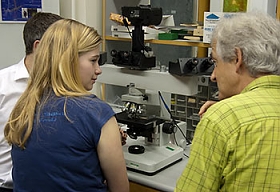
On 25th March the Unit held its sixth Open Day for local schools with over 80 students taking part from six local schools. Dr Jozsef Csicsvari gave an introductory talk and an outline about the Unit's work and some basic facts about the brain. Students then spent time in the laboratories, getting hands-on experience with instruments and real specimens, providing a glimpse of what to expect in a working research laboratory. They all visited two groups. Feedback was collected from students, which indicated that they found the visit very helpful and the research highly useful, as well as interesting. Many students asked how to become a research scientist as well.The teachers also found the experience very useful and we were told that after last year's visit some students were inspired to make University applications for various bioscience degrees, including medicine. Some student highlights of the visit include: looking at specimens in the electron microscope, seeing how the brains were sectioned, learning about copines, the confocal microscope in action, Parkinson's talk, understanding how to monitor brain activity and how such activity can represent learning processes. Our thanks to all who participated and made this day possible.
- Unit5 Feb 2010
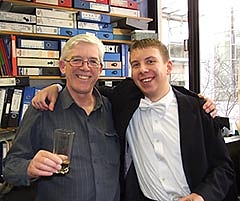
Jonathan Moss successfully defended his thesis on the 5th February 2010. Jonathan was supervised by Prof. Paul Bolam (on the left in the first photo). His internal examiner was Dr. Stephanie Cragg, and his external was Prof Anders Björklund (on the left in the second photo).
- Unit29 Jan 2010
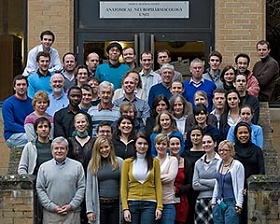
The Unit held its biannual Science Day on Friday 29th January 2010. Presentations featured ongoing projects and future proposals.
- Unit18 Dec 2009
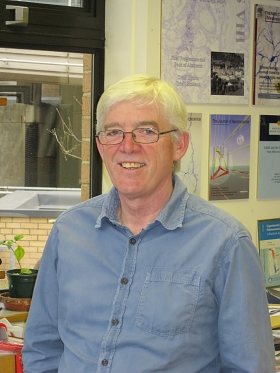
In recognition of Paul's contribution to the Council's work in general, and to the Unit's research programme in particular, Paul has been promoted to Associate Director with effect from the 1st of December. Paul joined the Department of Pharmacology in 1978 as Departmental Demonstrator and in David Smith's research group, interacting with Peter Somogyi, developed his research direction dissecting the neuronal networks of the basal ganglia. He received a Medical Research Council Senior Research Fellowship in 1983 and became a founding member of the Unit when it was set up in 1985. His research proposals on the basal ganglia received increasing support in each of the 4 quinquennial MRC reviews and his results and mentoring spawned the latest group in the Unit headed by Peter Magill, who was his DPhil student and has been his main collaborator.
- Unit18 Dec 2009
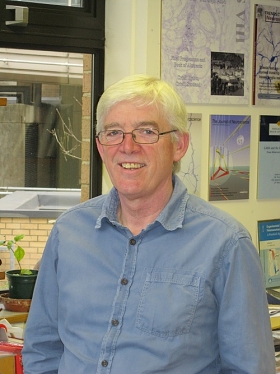
Paul Bolam gave the Unit Christmas Lecture on "Bees and Beekeeping". He covered some historical aspects of mans interaction bees, the natural history of the honey bee (Apis mellifera), hive management and products of the hive. The lecture was followed by wine, mince pies and honey tasting.
- Unit13 Dec 2009
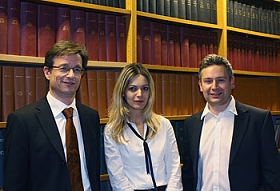
Tatjana Lalic successfully defended her D.Phil. thesis, 'Synaptic transmission of hippocampal mossy fibres in health and disease', on the 4th of December 2009. Tatjana was supervised by Dr. Marco Capogna. Her internal examiner was Dr. Colin Akerman (on the right), and her external was Dr. Urs Gerber from the University of Zurich, Switzerland (on the left).
- Unit13 Nov 2009

About twenty science teachers of Oxford's local schools visited our Unit on the 13th of November 2009. Sixteen schools were represented.
First, Dr. Marco Capogna gave an outline about the Unit's work and introduced some basic facts about the brain. This was followed by a comprehensive talk by Dr. Joseph O' Neill, who explained the links between learning and memory, hippocampus and sleep. The talks raised several questions and a lively discussion took place.
Next, visitors were divided into three groups and spent time in most of the Unit's labs, getting hands-on experience with instruments and real specimens, providing a glimpse of what to expect in a working research laboratory. Highlights of the visit included: generation of action potentials in brain slices, Parkinson's video, looking at specimens in microscopes, visualization of fluorescence images, visualization of dendritic and axonal processes of nerve cells. Booklets on our MRC Unit, MRC brain research and Introduction to Neuroscience were distributed to the visitors.
Our thanks to all who participated and made this day possible.
- Unit3 Nov 2009
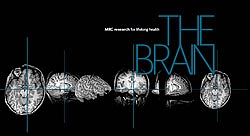
The MRC has published a booklet entitled 'The Brain', targetted at the general public. This booklet explores what the brain is, how it works, and how MRC-funded research is helping us to understand more about it. Unit members can obtain printed copies from the Unit reception. Link to booklet download.
- Unit3 Nov 2009
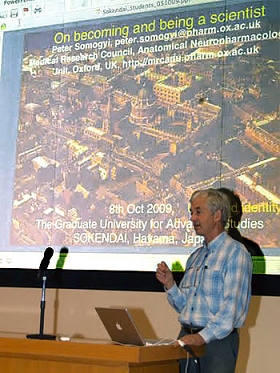 Prof. Peter Somogyi deliveres a lecture to the students of Sokendai.
Prof. Peter Somogyi deliveres a lecture to the students of Sokendai.Peter Somogyi delivered two lectures about his experiences and principles as a scientist to postgraduate research students in Japan. On the 8th of October, he lectured at the Hayama Campus in Shonan village (Miura peninsula, near Yokohama) to students from Institutes all over Japan, including international students, at the induction ceremony to the Graduate University of Advanced Studies (SOKENDAI, http://www.soken.ac.jp). The theme of the two days programme was "Unity and Identity", which fit perfectly Peter's research on identified neurons in complex networks of the brain. The meeting is organized for new students by more senior students, and the President Prof. Takahata Naoyuki inducts the students in the presence of the faculty. This year, typhoon Melor somewhat disrupted plans, as it hit Honshu on the day of the ceremony and brought to a standstill the Japanese train network.
The second lecture was given on the 14th of October to graduate students of the National Institute for Physiological Sciences, Okazaki, Japan. See the abstract of the lectures.
- Unit22 Oct 2009
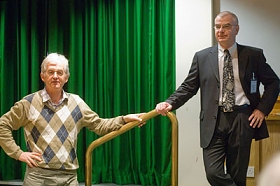
Acknowledging the survival of Professors György Buzsáki and Péter Somogyi to the tender age of 60, former Unit member Tamás Freund, Director of the Institute of Experimental Medicine of the Hungarian Academy of Sciences, Budapest, has organised a satellite symposium to the IBRO International Workshop (21-23 January 2010) at Pécs in Hungary. The symposium is free and has a spectacular spread of speakers of the great and famous type.